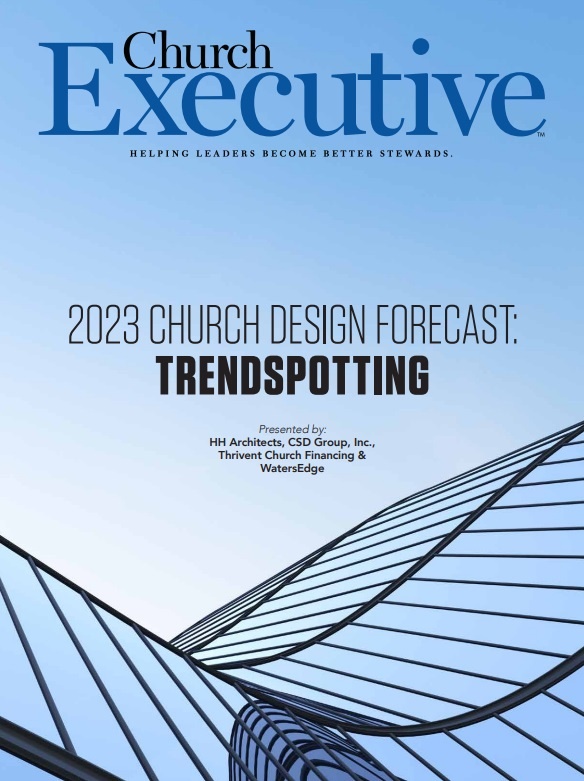
A lending veteran’s perspective
 WatersEdge began lending to churches in 1953 and has since partnered with more than 1,600 congregations looking to grow or refinance. During that nearly 70-year span, we’ve seen it all: boom years, recessions, and everything in between.
WatersEdge began lending to churches in 1953 and has since partnered with more than 1,600 congregations looking to grow or refinance. During that nearly 70-year span, we’ve seen it all: boom years, recessions, and everything in between.
So, as churches ride the waves of yet another tumultuous period in our nation’s economy, let me offer you some encouragement: God’s Kingdom isn’t dependent on the market. Our Savior hasn’t stopped moving!
Churches’ need to expand hasn’t stopped, either.

Chief Lending Officer
WatersEdge
Thankfully, congregations of all sizes have a myriad of options when considering how to accommodate growth. Here are some of the trends I’m seeing in today’s church construction environment, plus some tips to help you and your team secure financing and plan effectively for your next project.
There’s value in variety
From my perspective at WatersEdge, it’s difficult to nail down any concrete church construction trends, but there are plenty of commonalities to explore. It’s likely no surprise that we continue to see many traditional projects — new sanctuaries and other church buildings needed to accommodate growth. But we also see proposals outside the norm, like adaptive reuse projects or other creative renovations. While I don’t think there’s any specific type of building being built, what’s most important is ensuring that your church’s plan lines up with your ministry goals and is financially realistic.
Location, location, location
According to recent research, more congregations are moving out of the suburbs and into the cities to reach denser population centers. In my experience, that can sometimes be true, especially for younger churches or pastors who feel a burden for the inner city.
But it’s not always the case.
I still see plenty of congregations that opt for larger campuses in more open, suburban or even rural areas. So, if that’s where God is leading you and your church, financing shouldn’t be an obstacle.
The trends of the past are staying put

Remember the building bonanza of family life centers, athletic complexes, and education spaces? These were trendy projects in the 1990s and early 2000s, but I’m not seeing nearly as many today, if any. Instead, most congregations are prioritizing worship space over any other area, with an emphasis on using that worship space to host events throughout the week to maximize usefulness.
It’s not always about growth
I recently worked with a large church in Georgia that’s in the process of downsizing. The congregation realized that they could accomplish the same thing in a 100,000-square-foot building that they’re currently doing in their existing 160,000-square-foot facility. So, the church got a loan from WatersEdge to buy land to construct a smaller, custom space.
Another church, in Kansas, is downsizing even more aggressively, from 90,000 square feet to 16,000 square feet. I’m also working with another congregation that is re-envisioning its sanctuary construction project as a multipurpose space, better suited for the broad spectrum of the church’s needs. It can seem counterintuitive to think smaller, but sometimes downsizing is the right choice — especially in a high-building cost, high-interest rate environment.
Think beyond new construction
Brand-new buildings aren’t the only game in town. I’ve seen many churches get creative in their expansion plans, including one that renovated a neighborhood grocery store into its primary facility.
While this kind of project might seem quirky, it can make a lot of sense for churches looking to save money and create a unique and exciting experience. Securing a loan for one of these adaptive reuse projects is essentially the same as securing one for new construction. Just be open with your lender to ensure that financing lines up with your new plan — and make sure that all of the property you purchase is zoned for church use.
One last tip…
This might seem obvious, but it’s not something that everyone considers: whether using a ministry-based lender or a traditional lender — like a bank or credit union — it’s important for your building committee to consult the team handling your loan early in the process. I’ve seen church leaders go through the entire planning stage only to discover that they didn’t qualify for a big enough loan for the building they had in mind and were forced to go back to the drawing board. Your lender can tell you whether your church’s proposal is feasible for the projected price tag. By coming together early, you’ll save time.
Jerry Vaughan brings more than 40 years of lending experience in both the commercial and non-profit sectors to WatersEdge. Since joining WatersEdge in 2000, he has assisted hundreds of churches with more than $460 million in loans.


